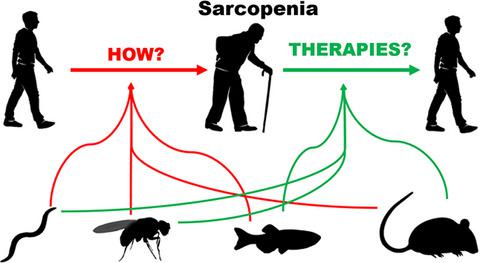当前位置:
X-MOL 学术
›
Aging Cell
›
论文详情
Our official English website, www.x-mol.net, welcomes your feedback! (Note: you will need to create a separate account there.)
Animal models of sarcopenia.
Aging Cell ( IF 7.8 ) Pub Date : 2020-08-28 , DOI: 10.1111/acel.13223 Courtney J Christian 1 , Guy M Benian 1
Aging Cell ( IF 7.8 ) Pub Date : 2020-08-28 , DOI: 10.1111/acel.13223 Courtney J Christian 1 , Guy M Benian 1
Affiliation

|
Sarcopenia is the age‐related decline in muscle mass and function without any underlying disease. The exact molecular mechanisms responsible for this pathology remain unknown. The use of model organisms, such as mice, rats, flies, and worms, has advanced the field of sarcopenia research by identifying therapeutic strategies and genetic mutations that result in improved muscle mass and function of elderly animals. This review discusses molecular and therapeutic discoveries made using these model organisms and how these animals can be further utilized to better understand sarcopenia pathogenesis. In rodents, flies, and worms, dietary restriction improves muscle performance in old animals. In rodents and worms, exercise and a number of naturally occurring compounds alleviate sarcopenia. Reduction in the insulin/IGF1 receptor pathway, well known to promote longevity, improves sarcopenia in worms and flies. Mitochondrial dysfunction may contribute to the pathogenesis of sarcopenia: In rodents, there is age‐dependent reduction in mitochondrial mass and a change in morphology; in nematodes, there is age‐dependent fragmentation of mitochondria that precedes sarcomeric disorganization. In Drosophila and rats, components of the 26S proteasome are elevated in aged muscle. An advantage of the worm and fly models is that these organisms lack muscle stem cells, and thus processes that promote the maintenance of already assembled muscle, can be identified without the confounding influence of muscle regeneration. Zebrafish are an up and coming model of sarcopenia for future consideration. A better understanding of the molecular changes behind sarcopenia will help researchers develop better therapies to improve the muscle health of elderly individuals.
中文翻译:

肌肉减少症的动物模型。
肌肉减少症是与年龄相关的肌肉质量和功能下降,而没有任何潜在疾病。导致这种病理的确切分子机制仍然未知。小鼠、大鼠、苍蝇和蠕虫等模型生物的使用,通过确定可改善老年动物肌肉质量和功能的治疗策略和基因突变,推进了肌肉减少症的研究领域。本综述讨论了使用这些模型生物的分子和治疗发现,以及如何进一步利用这些动物来更好地了解肌肉减少症的发病机制。在啮齿动物、苍蝇和蠕虫中,饮食限制可以改善老年动物的肌肉性能。在啮齿动物和蠕虫中,锻炼和一些天然存在的化合物可以缓解肌肉减少症。减少胰岛素/IGF1受体通路,众所周知,可以促进长寿,改善蠕虫和苍蝇的肌肉减少症。线粒体功能障碍可能与肌肉减少症的发病机制有关:在啮齿类动物中,线粒体质量随年龄增长而减少,形态发生改变;在线虫中,在肌节解体之前,存在与年龄相关的线粒体断裂。在果蝇和大鼠中,老化肌肉中 26S 蛋白酶体的成分升高。蠕虫和苍蝇模型的一个优势是这些生物体缺乏肌肉干细胞,因此可以在没有肌肉再生的混杂影响的情况下识别促进已组装肌肉维持的过程。斑马鱼是一种新兴的肌肉减少症模型,供未来考虑。
更新日期:2020-10-23
中文翻译:

肌肉减少症的动物模型。
肌肉减少症是与年龄相关的肌肉质量和功能下降,而没有任何潜在疾病。导致这种病理的确切分子机制仍然未知。小鼠、大鼠、苍蝇和蠕虫等模型生物的使用,通过确定可改善老年动物肌肉质量和功能的治疗策略和基因突变,推进了肌肉减少症的研究领域。本综述讨论了使用这些模型生物的分子和治疗发现,以及如何进一步利用这些动物来更好地了解肌肉减少症的发病机制。在啮齿动物、苍蝇和蠕虫中,饮食限制可以改善老年动物的肌肉性能。在啮齿动物和蠕虫中,锻炼和一些天然存在的化合物可以缓解肌肉减少症。减少胰岛素/IGF1受体通路,众所周知,可以促进长寿,改善蠕虫和苍蝇的肌肉减少症。线粒体功能障碍可能与肌肉减少症的发病机制有关:在啮齿类动物中,线粒体质量随年龄增长而减少,形态发生改变;在线虫中,在肌节解体之前,存在与年龄相关的线粒体断裂。在果蝇和大鼠中,老化肌肉中 26S 蛋白酶体的成分升高。蠕虫和苍蝇模型的一个优势是这些生物体缺乏肌肉干细胞,因此可以在没有肌肉再生的混杂影响的情况下识别促进已组装肌肉维持的过程。斑马鱼是一种新兴的肌肉减少症模型,供未来考虑。


























 京公网安备 11010802027423号
京公网安备 11010802027423号